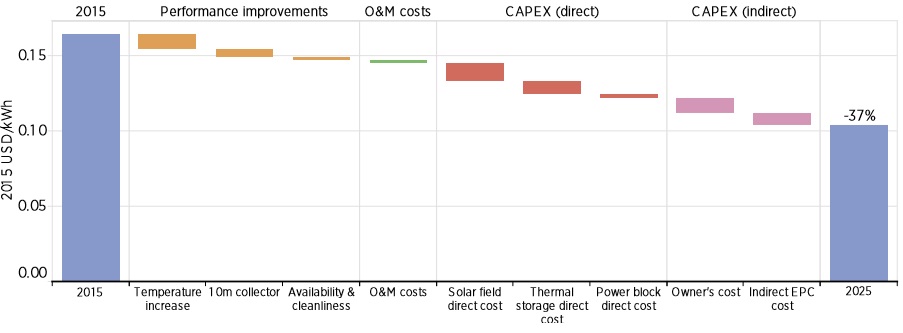Rioglass targets 550° Celsius CSP parabolic trough storage by 2020
Rioglass is preparing to deploy temperature-resistant receivers on utility-scale molten salt storage plants in a move set to boost competitiveness of parabolic trough technology, Jeroen Van Schijndel, Chief Sales & Marketing Officer at Rioglass, said.

Related Articles
Thermal energy storage (TES) has become a key asset for CSP plants as developers look to leverage cost advantages over other renewable energy sources for longer dispatch periods. Some 15 out of the 17 utility-scale CSP projects under construction around the world include TES, according to the CSP Today Global Tracker.
In recent years, CSP developers have tended towards using solar tower technology to benefit from high-temperature molten salt storage systems. Parabolic trough plants have typically used synthetic oil as heat transfer fluid (HTF) which has curbed temperatures thresholds and limited the efficiency of storage systems.
This could soon change following the latest technological innovations. After several years of development and testing, high-temperature molten salt based parabolic trough systems will soon be deployed in large-scale plants, Van Schijndel told the Africa New Energy 2017 conference on March 7.
Rioglass, a major supplier of mirrors and receivers to CSP plants, has developed a next generation solar receiver which will raise the efficiency of plants using molten salt and other high temperature HTFs, he said.
Rioglass’ latest solar receiver technology incorporates new components and coating solutions to withstand temperatures of around 550 degrees Celsius, removing the need for a heat exchanger to the high temperature storage system.
Access to higher temperatures could see the installed costs of storage for parabolic trough plants fall by 50% by 2025, the International Renewable Energy Agency (IRENA) said in a report published in June 2016.
Rioglass’ receivers can be used with a number of high temperature HTFs and the receivers have been tested across a range of different plant concepts, Van Schijndel said.
“Some of the big developers are now pushing for commercialization of this in their plants..we expect to have this commercialized within the next three years, on plant scale,” he said.
Thermal energy storage cost reduction potential (parabolic trough)

Source: IRENA report 'The Power to Change' (2016)
Operating gains
CSP developers must implement a wide range of efficiency measures in the coming years to improve competitiveness versus other generation types.
Around 5 GW of CSP capacity has been installed globally. Compared with PV and wind, CSP technology is still in a relatively early stage of maturity and this means the cost reduction potential for CSP plants remains high.
The levelized cost of energy (LCOE) for parabolic trough plants could drop by 37% by 2025 to $60/MWh while the cost of solar towers could drop by 43% to $70/MWh, IRENA said in June 2016.
LCOE reduction potential (parabolic trough)
 Source: IRENA report 'The Power to Change' (2016)
Source: IRENA report 'The Power to Change' (2016)
Rioglass recently launched a non-degradable coating solation to boost efficiency across different multiple generations of receiver tubes for parabolic trough plants.
Testing at Germany's DLR solar research institute has shown that the new coating can eliminate degradation of optical efficiency and heat losses over the entire lifetime of the receivers, Van Schijndel said.
Based on a 100 MW plant with four hours of storage (1 GW), the coating solution can boost total output by 150 GWh to 11,300 GWh, representing 6 GWh of extra output per year, he said.
Rioglass estimates the technology can increase total plant revenues by 30 million euros ($32.0 million) and cut operations and maintenance costs by 7 million euros.
“We think this is a game changer in the industry because of its potential to add so much added value,” Van Schijndel said.
Another area of research for Rioglass has been the mitigation of soiling, which can incur significant operations and maintenance costs in regions such as the Middle East and North Africa (MENA).
Rioglass has developed a new anti-soiling coating solution for its mirror technology and this has now been successfully integrated into the mirror tempering process, Van Schijndel said.
"It's now ready for market launch... This is something which will be done in the coming months," he said.
New Energy Update
